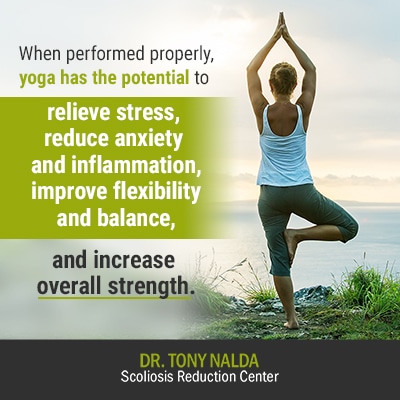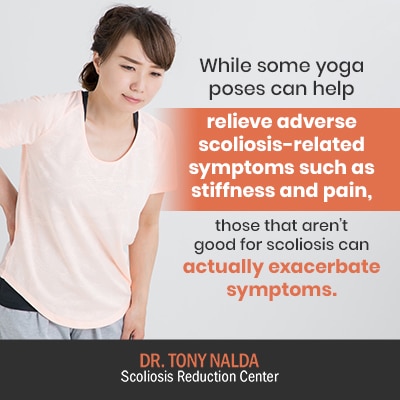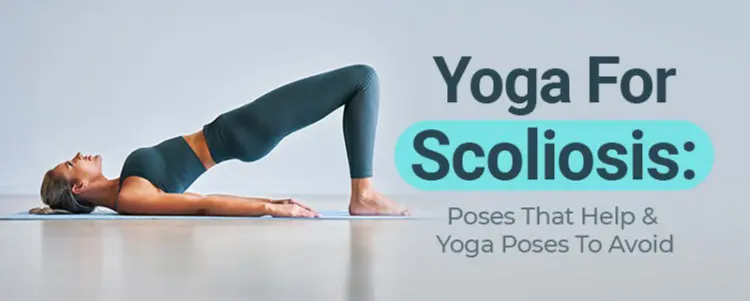While any exercise regime has to first be approved by a person’s scoliosis-treatment provider, when customized to address the specifics of a patient’s condition, yoga can be an effective way of keeping the spine and its surrounding muscles strong and flexible. On its own, however, yoga is not enough to induce a structural change and therefore should not be considered a treatment option for scoliosis.
If approved and incorporated into an integrative treatment approach by a scoliosis chiropractor, yoga can improve spine health and effectively complement other treatment disciplines. Yoga poses to avoid are those that expose the spine to additional adverse tension.
Before we move on to addressing the specifics of how yoga can make a difference for scoliosis, let’s first talk about yoga in general terms, including its physical and mental health benefits.
The Ancient Practice of Yoga
The ancient practice of yoga extends as far back as 5,000 years in India. Throughout modern history, it has steadily gained in popularity, particularly in the Western world as people who practice yoga enjoy its benefits both for mental and physical health.

In fact, many of these benefits are now backed by science. When performed properly, yoga has the potential to relieve stress, reduce anxiety and inflammation, improve flexibility and balance, and increase overall strength.
While we know that yoga can be highly beneficial for the average person, what about for people with abnormal spinal curvatures? Can it be an effective element of scoliosis treatment, and if so, how? Can it be harmful for people with scoliosis?
These are important questions to ask, and while the traditional approach to scoliosis treatment relies on observation, bracing, and surgery, modern and dynamic treatment approaches have evolved to offer different options and potential outcomes.
That being said, there is a big difference between doing yoga, if you have scoliosis, or doing yoga specifically suited to help with a person’s scoliosis. There are scoliosis-specific yoga programs out there that help with scoliosis by combining the practice of yoga with scoliosis-specific professional care.
Let’s move on to the potential benefits that yoga can offer scoliosis patients when integrated into a proactive and functional treatment approach.
Yoga and Scoliosis
Yoga can be a fantastic form of exercise for certain types of muscles, and in the context of scoliosis, many of these muscles also play a role in providing the spine with support and stabilization: important for scoliosis management.
Yoga poses generally involve holding specific positions for long periods of time, engaging type-one, slow-twitch muscles and involve long isometric stretches.
In most cases, these benefits improve spine health by increasing its strength and flexibility. In addition, muscles that are strengthened by yoga are also important for posture, and we know that postural changes are indicators for, and symptoms of, scoliosis.
When used effectively, yoga has the potential to help people manage scoliosis-related pain (for those experiencing it) and maintain good posture, which are all good things.
What I want to be clear on, however, is that yoga on its own, does not have the power to induce a structural change. As scoliosis is structural, effective treatment has to, first and foremost, impact a patient’s condition on a structural level.
When a person develops an abnormal curvature, their spine is no longer aligned, meaning its vertebrae (bones of the spine) are no longer stacked neatly on top of one another as they should be. No exercise alone can realign a scoliotic spine, but certain scoliosis-specific exercises and stretches can augment other forms of treatment that can impact scoliosis on a structural level, such as chiropractic care.
So yoga on its own, while it carries many potential scoliosis-related benefits, is not an effective means by which a curvature reduction can be achieved, and that’s the important distinction to understand when it comes to yoga and scoliosis; part of the reason for this is an issue of symmetry.
Symmetry, Scoliosis, and Yoga
Generally, yoga is practiced in a symmetrical manner in a way that assumes both sides of the body are perfect mirror images of each other, but for people with scoliosis, we know this is not the case.
As an abnormal sideways curvature of the spine develops, it introduces a lot of uneven forces to the body, and these uneven forces have an overall asymmetrical effect, often producing postural changes that give the body an asymmetrical appearance.
This is why structurally reducing a scoliosis is simply beyond the scope of yoga as it operates under the principle that the body is symmetrical, which is not the case for people living with scoliosis.
By the time a person has mastered the art of yoga and can perform the poses properly, asymmetrical motion has occurred in the scoliotic spine as the spine is no longer moving in the same manner in both directions, and this can exacerbate issues related to the condition.
To better understand this principle, let’s use the example of wanting to symmetrically work the biceps in both upper arms, and let’s imagine that one arm has a limited range of motion due to a related elbow injury: one arm has a full range of motion, while the other has a very limited range of motion.
Even when using an identical set of exercises for each arm, the arm with the full range of motion will reap the full benefits of the workout, while the other impaired arm will not. Using yoga for scoliosis has a similar effect as the muscles surrounding the spine don’t have equal strength and/or function.
So for a person who has received a scoliosis diagnosis, yoga is minimally effective when it comes to reducing the patient’s curvature, and this is due to asymmetrical joint motion. At this point, the condition is structural, and there’s very little, if anything, that yoga can do on its own to help with curvature reduction or restoring movement.
It’s also possible for some yoga poses to actually exacerbate scoliosis symptoms, especially with certain curvature types and/or condition severities, and especially if the yoga poses weren’t recommended by an expert with a focus on scoliosis, which the majority of yogis are not.
Again, that’s not to say that yoga can’t offer scoliosis-related benefits in terms of improving overall mental health and physical strength, which better equips the body to deal with the rigors of treatment and life with the condition, but if it’s regarded as a potential treatment form on its own, it simply is not an effective option.
So now that we have talked about how yoga can help create certain conditions within the body that are more conducive to healing and positive responses to treatment, while also touching on how it can’t impact scoliosis on a structural level, you’re likely wondering which yoga poses are good for scoliosis, and which ones to avoid.
Let’s move on to looking at some specific yoga poses: those that can help and those that can hinder.
Helpful Yoga Poses for Scoliosis
The primary goal of yoga for scoliosis is to make improvements to a patient’s mobility, manage pain, and increase core strength so the spine is better supported and stabilized. There are certain yoga poses that can help with these things, especially when combined with other scoliosis-specific exercises and treatment disciplines.
However, before yoga poses are integrated into an effective scoliosis-specific exercise regime, a patient’s curvature location and pattern has to be taken into account as every case is different; this way, poses that exacerbate symptoms are avoided, and poses with the potential to make a positive impact are chosen.
Basically, a patient, and the person recommending certain yoga poses for scoliosis, needs to understand what type of curvature pattern and angle of trunk rotation (ATR) they are dealing with; that way, they will understand which poses can actually complement treatment and make positive improvements.
Some yoga poses that can be helpful for scoliosis, if they are deemed appropriate for a patient’s particular condition include:
- Side plank
- Downward dog
- Mountain pose
- Warrior pose
Side Plank
Performing a side plank pose properly can help with asymmetrical strengthening.
The pose starts by lying on one side with the legs extended and keeping the head aligned with the spine. Then lift the hips and knees from the floor and push up with the arm, while engaging the core, and make sure the torso is straight and aligned with the rest of the body.
The arm and core will support the body weight while the position is held, and the sides can be alternated.
By holding the posture on the convex side of the spine (the side that’s rounded outward), this can help strengthen the convex side of the curvature’s abdominal and spinal muscles which, in theory, bend the spine away from the stronger side to improve the spine’s strength.
While there has been speculation that the side plank might have the potential to reduce a patient’s Cobb angle if done a certain number of times throughout the day, studies suggest this is not the case, and that the benefits of the side plank for scoliosis are more indirectly related to increasing muscles and spinal strength, rather than actually reducing a curvature.
Downward Dog
The downward dog involves starting in a plank position with hands flat on the floor and arms stretched out straight, and then pushing the hips back and up into an upside-down ‘V’ position, then pulling the hips back down towards the floor while taking deep breaths.
This pose is known to alleviate spinal strain by exposing the spine to a lengthening motion while evenly distributing the body’s weight onto the legs.
With practice, this pose can help decrease pain and discomfort due to stiff muscles and spinal rigidity and can increase flexibility.
Mountain Pose
The mountain pose is a great position for promoting good posture, balance, and increasing core strength.
The pose involves standing with the feet aligned with the hips and the shoulders relaxed. While tightening the thigh muscles and keeping the feet firmly on the ground, extend the toes up and down, practicing balance while shifting weight between the balls of the feet and the heels.
Warrior Pose
The warrior pose is good for scoliosis because it improves balance, enhances stamina, and when practiced properly and regularly, it can lead to a stronger back, which means a better supported spine.
The warrior pose helps loosen constricted psoas muscles, which is associated with lumbar scoliosis.
The warrior pose is performed by standing in a lunge position while lifting the arms upward and stretching the thighs. Next, move the back leg further back while reaching the arms outward.
Now that we have discussed some yoga poses that can be helpful for scoliosis, let’s move on to discussing some that aren’t.
Yoga Poses to Avoid for Scoliosis Patients

While some yoga poses can help relieve adverse scoliosis-related symptoms such as stiffness and pain, those that aren’t good for scoliosis can actually exacerbate symptoms.
When it comes to yoga poses to avoid for people with scoliosis, again, every case is different, but in general, poses that involve bending backwards and hyperextending the middle back, such as the cobra and locust, can actually increase an abnormal spinal curve while in the position.
In addition, poses that involve twisting the torso can be harmful as when the shoulders and rib cage are twisted against the pelvis, the motion can increase the contortions that characterize a scoliotic spine.
Poses such as the triangle and seated twist are also not recommended for scoliosis because they involve unnaturally bending the rib cage, which can exacerbate the asymmetrical effect that scoliosis tends to have on the rib cage.
Another pose to avoid is the shoulder stand as this pose bends the head forward at a sharp angle, overextending the neck muscles and increasing the weight of the head on the cervical spine and shoulders.
As you now know, while there are many therapeutic benefits associated with yoga for scoliosis, those benefits are only forthcoming if specific poses are selected that complement other forms of applied treatment, and if they specifically address an individual’s condition characteristics like curvature pattern and location.
Conclusion
Yoga has been practiced for thousands of years, and its track record speaks for itself in terms of its potential mental and physical health benefits.
Yoga provides a wide range of scientifically-backed benefits to those who practice it effectively, and for those living with scoliosis who have yoga integrated into a customized program of scoliosis-specific professional care, it can also offer certain benefits.
What people need to understand, however, is that yoga for scoliosis provides more of an indirect benefit by helping patients to manage stress, stay strong and flexible, and alleviate scoliosis-related discomfort; this is different than saying that yoga is an effective treatment option for scoliosis because this suggests that yoga can actually reduce a person’s curvature, which is not the case.
As scoliosis is structural, effective treatment has to impact it on a structural level by realigning the spine, which is simply beyond the scope of yoga alone.
When yoga poses are customized to a patient’s condition by an expert and performed properly, they can help indirectly by creating an environment within the body that is conducive to healing, but no yoga pose has the power to induce a structural change and actually reduce a patient’s Cobb angle.
So while certain yoga poses can help alleviate discomfort, increase flexibility and core strength, which has positive effects on scoliosis, they are not an effective form of treatment because they can’t actually reposition the vertebrae of the spine.
In addition, certain yoga poses can actually exacerbate scoliosis-related symptoms and cause more harm than good. These types of poses include those that involve twisting the torso, bending backwards, hyperextending the middle back, bending the rib cage, and/or unnaturally bending the head forward.
Here at the Scoliosis Reduction Center®, any form of exercise that is integrated into a treatment plan is scoliosis-specific and patient-specific. As every case is different, I have never used the same treatment plan twice.
Through an integrative and functional treatment approach, I strive to impact every patient’s condition on a structural level through combining chiropractic care, in-office therapy, custom-prescribed home exercises, and specialized corrective bracing.
Exercises and stretches are an important part of increasing core strength to improve the spine’s overall strength and support, and while yoga can help in this area, the poses have to be scoliosis-friendly and chosen to address the specific characteristics of a patient’s curvature.





